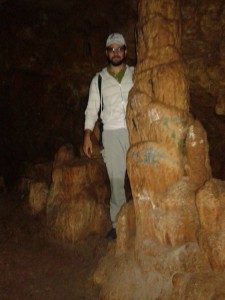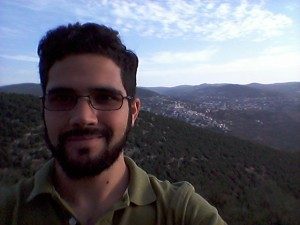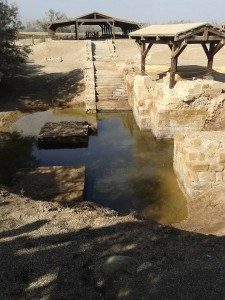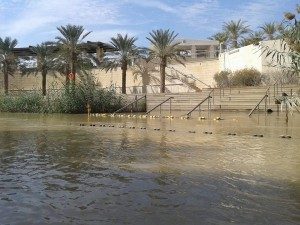Since we are in the capstone phase of our program here, each one of us is on our own, conducting independent research. We make our own schedule and go to the SIT HQ only when we need or want to. It sounds amazing, but amongst scheduling (and likely rescheduling) interviews, pouring through literature, and analyzing survey data, things can get a little mind-numbing. This weekend, therefore, I put my project aside and decided to do some traveling.
This past Friday, my host brother woke up with the desire to get out of the house as well. He wanted to hike; I wanted to go to Northern Jordan to pick olives. It was settled: we would travel to the mountain city of Ajloun that day. There, we could take full advantage of the gorgeous weather, we could hike, and I could pick olives. On our way out the door, we spontaneously invited my host brother’s friend, Sam, another American student doing PhD research here. He wanted to visit Dibeen Forest, an important site in Jordanian history, for his research. We met with him at a random street and got on our way, each with our own mission for the day. 
Our first stop was a cave near Ajloun, where we stopped to explore and hike the mountainside. I had never been cave-exploring before and it was phenomenal: pitch-black, rocky, muddy–what’s not to love? Host brother is really into nature and exploration, so he had a map of the cave, which we followed to almost reach the deepest point. At one point, oxygen started to become scarce and we had only a few hours to seek olives and Sam’s forest before sunset, so we decided to exit the cave. After a brief recovery with water and some nuts for energy, we began our exploration of the mountainside surrounding the cave area. That day, I learned thorny vines are generally not friendly. Nevertheless, it was great to be amongst vegetation and foliage after weeks of seeing rocks, dirt, and uniform beige tones in Amman.
I returned home with my olives, we got to hike, and Sam got to explore Dibeen for his research: Friday was a success. Putting my student hat back on, though, Dibeen is the forest in which the Palestinian resistance forces, known as the Fedayyeen, hid when they operated out of Jordan. Sam explained the history for us and showed us the valley in which the last battle between them and the Jordanian Army took place.
On the following day, I embarked on a trip to the Baptism Site (Al-Maghtas) near the Dead Sea with some friends. I’m not religious, but Al-Maghtas is a World Heritage Site and has important historic and academic value. I felt as though my trip to Jordan would have been incomplete had I not visited. Our group consisted–myself included– of a Muslim, a Wiccan, and 3 atheists, and we all went with the purpose of learning more about the site, its history, and significance.
The trip wasn’t terrible, but it was disappointing. The Jordanian side of Al-Maghtas (The river is shared by Jordan and Israel and the site is located in the West Bank) is underdeveloped and its informative potential unfulfilled. We arrived and noticed the tours departed from a small ticket office attached to a parking lot. Everything was mud and wood, very simple, which seemed appropriate given the nature of the site. A few minutes after our arrival, we embarked on a bus with a number of tourists (I picked up French, Portuguese, and Spanish) and were driven to another mud-and-wood house where we could purchase souvenirs (before we went through the tour). I went through the shop with a few people in mind who might appreciate a souvenir from the site, but I couldn’t find any valid justification for pricing a vial of “holy” water at $22, so I moved on.
After a few minutes in the shop, the group started walking down a prepared path toward the Baptism Site. This was well done; the path was clean and well-maintained. It was adorned with flowers and made the walk lovely, but it did not clash with the natural environment. The first stop in the tour was the historical baptism site, where geographers and theologians believe John the Baptist baptized Jesus of Nazareth and marked the beginning of Christianity. The area we were standing on to see the site was once under water; now only a puddle remains (see below). Use of the Jordan River as a water source in addition to environmental factors have shrunk the river itself and its adjacent water bodies, such as the baptism site (the baptism did not occur in the River Jordan itself, but in a spring that feeds into it. Today, water remains in the site because it is a spring, but it will never return to its former level (even if it could, the tour guide explained the site authorities would not allow it, lest rising water damages the ruins).
The tour guide did (try to) explain some of the deeper aspects of the site’s history and significance, but left some confusion in the air. We moved on to see a church I can tell you little about because, again, there was a lot of confusion as to what it was we were seeing and what its significance is. I enjoyed the murals and mosaics, but I can’t share with you anything substantial about it. I did, however, find a man with a table selling the same holy water I saw earlier at the shop. In this less formal setting (i.e. not in a store), my friend Kaylah and I were able to negotiate the water down to $6 and a souvenir she wanted to 1/3 the shop cost.
The next step was the one I was most excited about: the modern baptism site. This has nothing to do with Jesus’ baptism; it is simply a segment of the Jordan River that is used for baptisms today. What interested me, though, was the fact that the river was approximately 20 feet wide and that was all that separated Jordan from the Occupied West Bank. On our side, a wood structure with a palm roof provided shade for tourists in Jordan, patrolled by Jordanian Army soldiers. 20 feet away, a concrete and marble structure twice as tall shaded tourists in the West Bank, patrolled by Israeli Defense Forces. a line of floating devices marked the border. We dipped our feet in the water and took in the sights for a few minutes before heading back to the bus for transport back to the ticket office.
Our tour had lasted 45 minutes. We saw and learned little; we were determined to not return to Amman empty-headed, so we asked the tour guide if we could go see Elijah’s hill on the next tour bus if there was space on it. He seemed confused and asked us why we wanted to see that, then explained that such a “special” trip had to be approved by the administration anyway. So, we went to seek out the manager. Seeing our interest, he ordered the guide to take us to the hill, but explained that all other archaeological sites were inaccessible because they were still under development, including John’s (the Baptist) cave. We asked about the development and the renovations and why the experience was so short, given that something like this represents what seems to me like a site of paramount importance to Christians and scholars worldwide. He explained that funding is persistently a problem for the site, with most of its support coming from USAID and maintenance covered by ticket prices (about 20USD per foreigner; 5USD for Jordanians).
There is so much more in the area than the actual baptism site that it was frustrating that we (or anyone else, actually) could not see all of it. A friend of mine in the States brought up in a discussion we had that maintaining and developing this site should be the world’s responsibility, especially the Christian community worldwide; why should the burden fall on Jordan alone, which already has a persistent budgetary crisis? Fundraising is hard; we all know this from lugging around those giant boxes of chocolate in middle school and high school to raise money for random clubs and activities, but a cause like this should have more money that it knows what to do with. I want to learn more about the resource gap for the site, and I welcome theories if you have them.
All in all, enjoyable weekend. Now, I am typing this as a break from my research. I hope to have at least one or two more adventures before this project is due and my time here comes to a close. I am hearing a lot of support for a trip to the gulf of Aqaba from my colleagues, so there may be some beach pictures in the future. Stay tuned!



